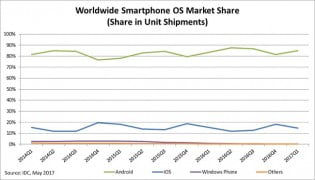It’s officially a two-horse race – IDC puts Windows Phone shipments for the first quarter of 2017 at a meager 0.1%. This matches the 0.1% share of the “Others” category (most competing OSes are now discontinued, even Tizen’s fate seems uncertain).
Android is the ruling OS with a solid 85% market share (it seems to hover around that point). This left the other 15% to iOS, but there’s a cycle – Q3 is a weak quarter, then the next-gen iPhones land in Q4 and iOS jumps several points.
| Period | Android | iOS | Windows Phone | Others |
| 2016Q1 | 83.4% | 15.4% | 0.8% | 0.4% |
| 2016Q2 | 87.6% | 11.7% | 0.4% | 0.3% |
| 2016Q3 | 86.8% | 12.5% | 0.3% | 0.4% |
| 2016Q4 | 81.4% | 18.2% | 0.2% | 0.2% |
| 2017Q1 | 85.0% | 14.7% | 0.1% | 0.1% |
It was such a Q4 jump – and a coinciding Q4 slump for Samsung, the Note7 period – when Apple briefly overtook Samsung as the leading smartphone manufacturer in the world. The Koreans are back on top, though they saw a flat quarter year on year.
Discounts helped push the Galaxy S7 duo, the Galaxy S8 flagships also saw high demand, but the company’s portfolio was strong on the lower levels too – the A and J series “drove significant volumes”. Their flagship looks made them popular in both developing and developed markets.
Apple meanwhile saw a tiny slump year over year, from 51.2 million to 50.7 million units. But we’re in the slow part of the cycle, IDC expects iOS handsets to be particularly strong in Q4 this year and especially next year. The analyst firm slightly lowered in 2017 forecast but increased the 2018 forecast, calling it a “very strong” year for Apple.


Source: IDC
Huawei is catching up, with an increase to 34.6 million units shipped in Q1 2017. Like Samsung, the company has a balanced portfolio of high-end (P10, Mate 9) and low/mid-range (Y series and Honor).
Oppo is also on the rise, the R9s in particular was a strong seller. Curiously, the company is stronger outside of its home country – it’s poplar in the rest of Asia and to some extent the Middle East and Africa. Improved after-sales services were called out as a positive factor.
Vivo’s story is similar, except the hero is the x9 and the country is India – the company sponsored the Indian Premier League and added more exclusive stores in the country. Single-day phone repairs in Indonesia are proving popular too.
| Period | Samsung | Apple | Huawei | OPPO | vivo | Others |
| 2016Q1 | 23.8% | 15.4% | 8.4% | 5.9% | 4.4% | 42.1% |
| 2016Q2 | 22.7% | 11.7% | 9.3% | 6.6% | 4.8% | 45.0% |
| 2016Q3 | 20.9% | 12.5% | 9.3% | 7.1% | 5.9% | 44.3% |
| 2016Q4 | 18.0% | 18.2% | 10.5% | 7.3% | 5.7% | 40.2% |
| 2017Q1 | 23.3% | 14.7% | 10.0% | 7.5% | 5.5% | 39.0% |
IDC notes the the average selling price – $220 in Q1 2017 – has been declining and will continue to do so. The firm expects the average price to drop to $198 in 2021 when a whopping 1.5 billion Android phones are expected to ship out.
And what of Microsoft and its Windows Phone platform? (Or is it Windows 10 Mobile now? Does it matter?) There was a precipitous drop of 80.9% to a paltry 1.1 million units shipped in the quarter. The “Surface phone” is clearly not happening and Redmond is doing little to encourage the few remaining WP partners.
[Source”timesofindia”]







